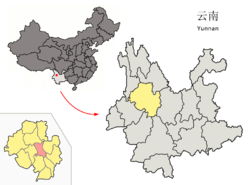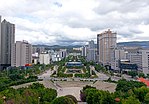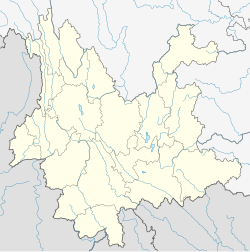Dali_City,_Yunnan
Dali City
City in Yunnan, China
Dali City (Chinese: 大理市, Bai: Dallit sil) is the county-level seat of the Dali Bai Autonomous Prefecture in northwestern Yunnan. Dali City is administered through 12 township-level districts, two of which are also commonly referred to as Dali.
This article needs additional citations for verification. (May 2020) |
Dali
大理市 · Dallit sil | |
|---|---|
From top, left to right: Xingsheng Bridge over Xi'er River, Erhai Lake, Dali Town, Cang Mountain, Yun Range Avenue in the city, Three Pagodas | |
 Locations of Dali City (pink) and Dali Prefecture (yellow) within Yunnan and China | |
| Coordinates (Dali Prefecture government): 25°36′23″N 100°16′03″E | |
| Country | China |
| Province | Yunnan |
| Autonomous prefecture | Dali |
| Municipal seat | Haidong |
| Area | |
| • Total | 1,738.63 km2 (671.29 sq mi) |
| Elevation | 1,975 m (6,480 ft) |
| Population (2021)[1] | |
| • Total | 771,128 |
| • Density | 443.5/km2 (1,149/sq mi) |
| Time zone | UTC+8 (China Standard) |
| Postal code | 671003 |
| Area code | 0872 |
| Climate | Cwb |
| Website | www |
| Yunnan e-Portal | |
| Dali City | |||||||
|---|---|---|---|---|---|---|---|
| Chinese | 大理市 | ||||||
| Literal meaning | "Great reason" | ||||||
| |||||||
Xiaguan (下关镇) formerly transliterated as Hsia-kuan, is the modern city centre and usually conflated with Dali City by virtue of being its seat. This town is the destination of most long-distance transportation heading to Dali and is sometimes referred to as Dali New Town (大理新镇) to avoid confusion.
Dali Town (大理镇) formerly known as Tali,[lower-alpha 1] is another division of Dali City, located 10 km (6.2 mi) north of Xiaguan. This town, commonly referred to as Dali Old Town (大理古城) to distinguish it from the city seat in Xiaguan, is usually the Dali referred to in tourist publications. The old town is one of the most popular tourist destinations in Yunnan, known for its natural scenery, historical and cultural heritage, and vibrant nightlife.[3]
Dali City is located in western Yunnan, approximately 250 km (160 mi) northwest of the provincial capital of Kunming.
Dali is situated in the transition area between the dramatic valleys of the Hengduan ranges on the eastern edge of the Tibetan Plateau and the distinctive mountains of the western Yungui Plateau. The county-level city surrounds Erhai Lake between the Cang Mountains to the west and Mount Jizu to the east. The county seat at Xiaguan is located at the outlet of the lake into the Yangbi River. Dali Old Town is situated on a fertile plain between the Cang Range and Erhai. This plain has traditionally been settled by the Bai and Yi minorities.
Its low latitude tempered by its high elevation, Dali has a mild subtropical highland climate (Köppen Cwb) with short, mild, dry winters and warm, rainy summers. Frost may occur in winter but the days still generally warm up to 16 °C (61 °F) or more. During summer, a majority of the days features some rainfall and daytime temperatures rise to 25 °C (77 °F). A great majority of the year's rainfall occurs from June to October. December 2013 was particularly marked for its high snowfall.
| Climate data for Dali (1991–2020 normals, extremes 1971–2010) | |||||||||||||
|---|---|---|---|---|---|---|---|---|---|---|---|---|---|
| Month | Jan | Feb | Mar | Apr | May | Jun | Jul | Aug | Sep | Oct | Nov | Dec | Year |
| Record high °C (°F) | 23.3 (73.9) |
24.7 (76.5) |
27.1 (80.8) |
29.5 (85.1) |
31.4 (88.5) |
31.6 (88.9) |
30.3 (86.5) |
29.9 (85.8) |
28.8 (83.8) |
27.1 (80.8) |
24.4 (75.9) |
24.5 (76.1) |
31.6 (88.9) |
| Mean daily maximum °C (°F) | 15.9 (60.6) |
17.8 (64.0) |
20.5 (68.9) |
23.2 (73.8) |
24.8 (76.6) |
25.7 (78.3) |
24.9 (76.8) |
24.9 (76.8) |
23.9 (75.0) |
21.8 (71.2) |
18.9 (66.0) |
16.5 (61.7) |
21.6 (70.8) |
| Daily mean °C (°F) | 8.9 (48.0) |
11.0 (51.8) |
13.9 (57.0) |
16.7 (62.1) |
19.0 (66.2) |
20.6 (69.1) |
20.1 (68.2) |
19.6 (67.3) |
18.3 (64.9) |
16.0 (60.8) |
11.9 (53.4) |
8.8 (47.8) |
15.4 (59.7) |
| Mean daily minimum °C (°F) | 3.1 (37.6) |
4.9 (40.8) |
7.8 (46.0) |
10.7 (51.3) |
13.9 (57.0) |
16.7 (62.1) |
16.8 (62.2) |
16.3 (61.3) |
14.9 (58.8) |
12.3 (54.1) |
7.1 (44.8) |
3.5 (38.3) |
10.7 (51.2) |
| Record low °C (°F) | −3.7 (25.3) |
−2.6 (27.3) |
−2.4 (27.7) |
1.0 (33.8) |
5.6 (42.1) |
8.5 (47.3) |
11.8 (53.2) |
10.5 (50.9) |
6.1 (43.0) |
4.2 (39.6) |
0.1 (32.2) |
−4.2 (24.4) |
−4.2 (24.4) |
| Average precipitation mm (inches) | 29.3 (1.15) |
28.2 (1.11) |
34.2 (1.35) |
27.6 (1.09) |
82.5 (3.25) |
131.3 (5.17) |
199.7 (7.86) |
220.4 (8.68) |
157.3 (6.19) |
91.8 (3.61) |
24.6 (0.97) |
11.1 (0.44) |
1,038 (40.87) |
| Average precipitation days (≥ 0.1 mm) | 4.2 | 5.6 | 8.0 | 9.0 | 10.7 | 14.7 | 19.4 | 19.0 | 17.5 | 12.9 | 5.0 | 2.6 | 128.6 |
| Average snowy days | 0.5 | 0.4 | 0.3 | 0.1 | 0 | 0 | 0 | 0 | 0 | 0 | 0.1 | 0.2 | 1.6 |
| Average relative humidity (%) | 55 | 51 | 49 | 53 | 63 | 74 | 82 | 83 | 82 | 77 | 69 | 64 | 67 |
| Mean monthly sunshine hours | 230.8 | 211.7 | 226.1 | 211.1 | 202.1 | 160.5 | 123.0 | 129.0 | 127.3 | 155.0 | 207.2 | 233.0 | 2,216.8 |
| Percent possible sunshine | 69 | 66 | 60 | 55 | 49 | 39 | 30 | 32 | 35 | 44 | 64 | 72 | 51 |
| Source 1: China Meteorological Administration[4][5] | |||||||||||||
| Source 2: Weather China[6] | |||||||||||||
Dali City has 3 subdistricts, 9 towns and 1 ethnic township.[7]
- 3 subdistricts
- Xiaguan (下关街道)
- Taihe (太和街道)
- Manjiang (满江街道)
- 9 towns
|
|
- 1 ethnic township
- Taiyi Yi Ethnic Township (太邑彝族乡)
- Former
- Qiliqiao Town (七里桥镇)
| Map |
|---|
Shangguan
Wanqiao
Yinqiao
Taihe
Taiyi Yi
Manjiang
Shuanglang
Wase
Haidong
Fengyi
|
The Dali area was formerly known as Xiemie (苴咩; Xiémiē). The old town was the medieval capital of both the Bai kingdom Nanzhao (779-902) and the Kingdom of Dali (937–1253). That city was razed and its records burnt during its conquest by China's Yuan Dynasty. The present old town was organized in the late 14th century under the Hongwu Emperor of the Ming Dynasty. The area became significantly Muslim (Hui) under the Yuan and Ming and was the center of the Panthay Rebellion against the Qing from 1856–1863. It was severely damaged during a massive earthquake in 1925.[8]
Rail and then air transport have permitted the area (particularly Dali Old Town) to become accessible to tourists in the 20th century. It is now one of China's official tourist cities[9] and, along with nearby Lijiang, one of the most popular towns. In order to preserve the appeal of the old town, industrial development is restricted to newer townships such as Xiaguan. Building codes mandate that new construction in the old town and surrounding countryside must conform to the traditional Chinese style, with tiled roofs and bricks, plaster, or white-washed walls.
Much of the local economy now revolves around tourism and services catering to travelers.
Historically, Dali was able to control some of the trade between India and China and independently famed for the woodworkers of the town of Xizhou and for its high-quality marble, used both for construction and decorative objects. It was so prominent in the latter that the modern Chinese word for marble is literally "Dali stone" (大理石; dàlǐshí).
- Third Month Fair (Sanyue Jie)
Local transport
Local transport includes buses, taxis, bicycles, and boats on Erhai Lake. Local busses 4 & 8 provide service from Xiaguan to the old town (1 hr).[11] Tourists often rent bicycles from one of the many rental stores in the old town and explore the region by bike, for instance on a special bike trail around the Erhai lake.
Air
Dali Fengyi Airport (DLU) is a domestic airport about 13 km (8.1 mi) east of Xiaguan on Weishan or Airport Rd. Taxis run about 60 RMB to Xiaguan or 90 RMB to the old town.[citation needed] It services (as of 2014) Kunming (20 min), Xishuangbanna (25 min), Chongqing (70 min), Chengdu Shuangliu (80 min), Shanghai, Beijing, Shenzhen, Guangzhou, and Guiyuan.
Road
Dali (i.e., Xiaguan) is connected to Kunming and points east by the Hangrui Expressway (G56), which also runs west to Ruili on the Burmese border. The Dali Expressway (G56₁₁) is a spur connecting it with Lijiang. The road to the old town is China National Highway 214, which connects to the expressway to Lijiang north of the lake. It also runs south from Xiaguan to Menghai near the Burmese border.
Long-distance busses run from the old town's west gate to Kunming (about 4½ hrs), Lijiang, and Shangri-La. Every Monday, service is also available to Shaping for its market.
Long-distance busses run from Xiaguan's stations on Jianshe Road.
Rail
Dali has its own railway station with daily services to Kunming and Lijiang. Service to Kunming used to consist of one train during the day and two trains running overnight, with sleeper cars. Per July 2018 Dali is connected to Kunming with a modern high-speed train link with a frequency of one train per hour. As the railway network expands in Yunnan, train service will become available to Shangri-La County and Ruili in the future.
The standard gauge line from Kunming, China to Kyaukphyu port opened in 2021, with a station at Dali.
Dali is one of Yunnan's most popular tourist destinations. Sights include:
- Dali Municipal Museum (大理市博物馆): This centrally located museum houses permanent exhibitions on archaeological findings from the region, on paintings and on Buddhist sculptures.
- Three Pagodas and Chongsheng Temple
- Demi-Gods and Semi-Devils film city
- Xizhou: a historical town famed for its architecture and woodwork
- Shuang lang: on the east side of the lake, once a small fishing village, now a rather high-class tourist destination, most buildings and businesses having overtaken the village since 2012. The coast is now completely built up by tourism estates.
- Cang Mountain, west of the Old City and the Three Pagodas
- Stele in memory of Kublai Khan's conquest of Yunnan (元世祖平云南碑), erected on top of a large stone tortoise in Sanyue Lane (三月街) at the foot of the Cang Mountain, west of the Old City.[12]
- Elizabeth Ho (何美倫) - Singer/Songwriter
- Jerry Ho (何兆燊) - Actor/Model, Activist (Featured in Ariana Grande's "thank u, next")
- City Population. "Dàlĭ Shì (County-level City)". Retrieved 19 December 2022.
- Baynes, T. S., ed. (1878), "China" , Encyclopædia Britannica, vol. 5 (9th ed.), New York: Charles Scribner's Sons
- "Dali Attractions". Travel China Guide. Retrieved 17 December 2014.
- 中国气象数据网 – WeatherBk Data (in Simplified Chinese). China Meteorological Administration. Retrieved 10 April 2023.
- 中国气象数据网 (in Simplified Chinese). China Meteorological Administration. Retrieved 10 April 2023.
- 大理 - 气象数据 -中国天气网 (in Chinese). Weather China. Retrieved 21 November 2022.
- National Geophysical Data Center / World Data Service (NGDC/WDS): NCEI/WDS Global Significant Earthquake Database. NOAA National Centers for Environmental Information. "Significant Earthquake Information". doi:10.7289/V5TD9V7K. Retrieved 14 March 2024.
- "Tourism City", China National Tourism Administration, CNTA Information Center, 2007
- Forbes, Andrew; Henley, David (2011). China's Ancient Tea Horse Road. Chiang Mai: Cognoscenti Books. ASIN: B005DQV7Q2
- "Dali Ancient Town" ChinaTour.net Accessed 2014-3-31
- 元世祖平云南碑. yunnaninfo.com. Archived from the original on 2009-12-28. Retrieved 2016-11-13.







